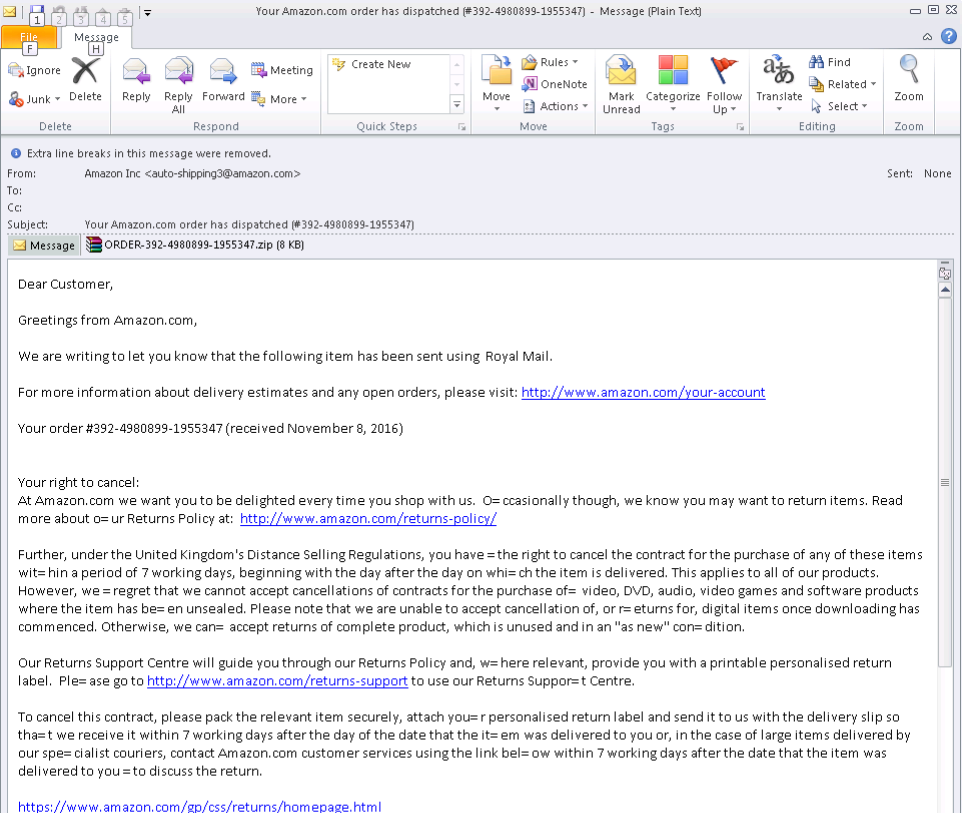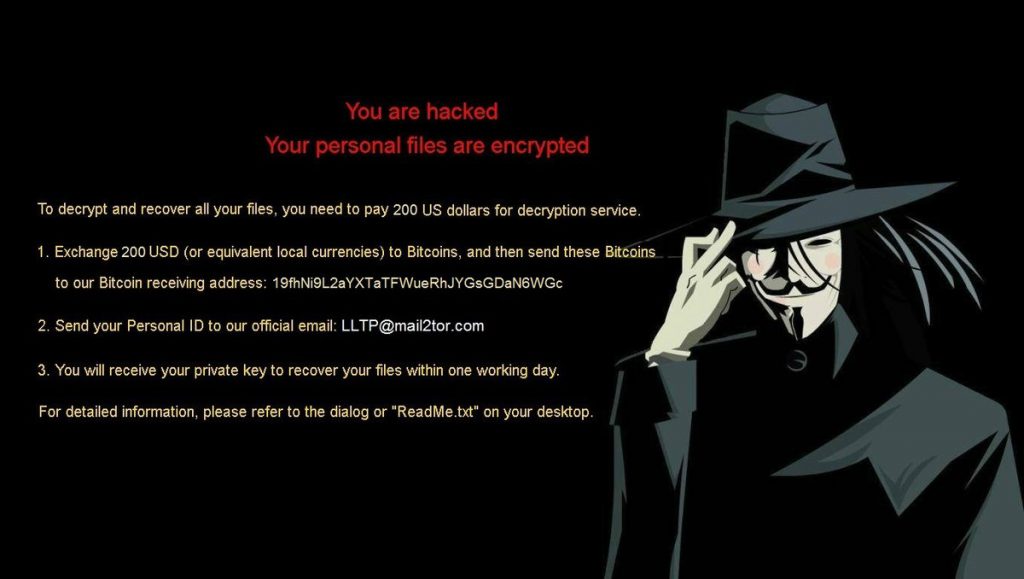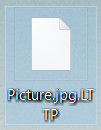 Article created to help you remove the LLTP ransomware infection from your computer and restore files encrypted with the .LLTP file extension.
Article created to help you remove the LLTP ransomware infection from your computer and restore files encrypted with the .LLTP file extension.
A ransomware virus, called LLTP ransomware has been reported to cause an immense amount of damage to the computers infected by it. The malware encrypts files on the computers using a combination of AES and RSA encryption ciphers which renders the files to no longer openable. And on top of this, LLTP also archives the files in a .RAR archive that is password-protected. The virus then changes the wallpaper and drops a ReadMe.txt file which has demands on how to pay a hefty ransom fee to get the encrypted files back. In case your computer was infected by the LLTP ransomware infection, we advise you to go through this article and learn how to cope with it.

Threat Summary
| Name | LLTP Locker |
| Type | Ransomware |
| Short Description | The ransomware uses 256-bit AES and RSA ciphers to encrypt files with an asymmetric algorithm to generate a decryption key different than the encryption one. |
| Symptoms | The ransomware will lock all your files with .Venusf extension appended to them and put a ransom note in your PC. The note states that you have to pay Bitcoins for decryption. |
| Distribution Method | Spam Emails, Email Attachments, Suspicious Sites |
| Detection Tool |
See If Your System Has Been Affected by malware
Download
Malware Removal Tool
|
| User Experience | Join Our Forum to Discuss VenusLocker Ransomware |

.LLTP Virus – How Does It Infect
Created by LLTP Locker Team, the cyber-criminals behind this virus may have decided that they will spread it via e-mail spam messages that contain malicious attachments. Usually the e-mails contain deceptive messages in them that aim to trick the user into opening an archive with malicious attachment or click on a URL.
Similar to what appears to be it’s older variant, VenusLocker, the e-mails sent out may pretend that they are containing a receipt, account information or warnings of suspicious activity. In the archives, there may be multiple malicious files that are even legitimate documents which have malicious macros within them. These malicious macros may activate a script which causes the infection. This is why users are advised to take extreme caution and learn how to protect themselves against such e-mails. In order to better protect yourself, please read our related article:

.LLTP Virus – What Does It Do
After infecting users, this possibly re-written VenusLocker variant, begins to drop it’s malicious files on the compromised PC. The files are multiple executable and temp type of files with random names as well as the virus name:
- LLTP3.5.exe
- {random name}.tmp
- LLTP.exe
- {random name}.doc.exe
- {random name}.exe.tmp
- {random name}.exe
- ReadMe.txt
The ReadMe.txt file is dropped on the desktop of the user profile and it has the same content as the original VenusLocker virus, only with the LTTP brand name on it:
—————————————- LTTP Locker ————————————
Unfortunately, you are hacked.
1. What happened to my files?
Your personal files, including your photos, documents, videos and other important files on this computer, have been encrypted
with RSA-4096, a strong encryption algorithm. RSA algorithm generates a public key and a private key for your computer. The
public key was used to encrypt your files a moment ago. The private key is necessary for you to decrypt and recover your files.
Now, your private key is stored on our secret Internet server. And there is no doubt that no one can recover your files without
your private key.
For further information about RSA algorithm, please refer to https://en.wikipedia.org/wiki/RSA_(cryptosystem)
2. How to decrypt my files?
To decrypt and recover your files, you have to pay 100 US Dollars for the private key and decryption service. Please note that
you have ONLY 72 HOURS to complete your payment. If your peyment do not be completed within time limit, your private key will be
deleted automatically by our server. All your files will be permanently encrypted, and nobody can recover them. Therefore, it is advised that you’d better not waste your time because there is no other way to recover your files except making a payment.
3. How to pay for my private key?
There are three steps to make a payment and recover your files:
1). For the security of transactions, all the payments must be completed via Bitcoin network. Thus, you need to exchange 100 US dollars
(or equivalent local currencies) to Bitcoins, and then send these Bitcoins (about 0.15 BTC) to the following address.
1Dj9YnMiciNgaKuyzKynygu7nB21tvV6QD
2). Send your personal ID to our official email: VenusLocker@mail2tor.com
Your personal ID is cc673bcfcf644d2c1a88893cb0ff8fa7
3). You will receive a decryptor and your private key to recover all your files within one working day.
4. What is Bitcoin?
Bitcoin is an innovative payment network and a new kind of money. It is based on an open-source cryptographic protocol that is independent of any central authority. Bitcoins can be transferred through a computer or a smartphone without an intermediate
financial institution.
5. How to make a payment with Bitcoin?
You can make a payment with Bitcoin based on Bitcoin Wallet or Based on Perfect Money. You can choose the way that is more convenient for you.
About Based on Bitcoin Wallet
1) Create a Bitcoin Wallet. We recommend Blockchain.info (https://blockchain.info/)
2) Buy the necessary amount of Bitcoins. Our recommendations are as follows.
LocalBitcoins.com — the fastest and easiest way to buy and sell Bitcoins.
CoinCafe.com — the simplest and fastest way to buy, sell and use Bitcoins.
BTCDirect.eu — the best for Europe.
CEX.IO — Visa / MasterCard
CoinMama.com — Visa / MasterCard
HowToBuyBitcoins.info — discover quickly how to buy and sell Bitcoins in your local currency.
3) As mentioned above, send about 0.15 BTC (equivalent to 100 USD) to our Bitcoin receiving address.
4) As mentioned above, and then, send us your personal ID via email, you will receive your private key soon.
About Based on Perfect Money
1) Create a Perfect Money account. (https://perfectmoney.is)
2) Visit to PMBitcoin.com. (https://pmbitcoin.com/btc)
Input our Bitcoin receiving an address in the “Bitcoin Wallet” textbox.
input 100 in the “Amount” textbox, the amount of Bitcoin will be calculated automatically.
click “PAY” button; then you can complete your payment with your Perfect Money account and local debit card.
6. If you have any problem, please feel free to contact us via official email.
Best Regards
The LTTP Locker Team
The LTTP Locker virus also changes the wallpaper of the infected computer, to the one used by the other variants:
In addition to this activity, the LTTP Locker ransomware may also cause a deletion of all shadow volume copies and backups on the affected computer. This is performed by using the vssadmin command in quiet mode:
→ vssadmin.exe delete shadows /all /Quiet

The .LTTP Locker Virus Encryption Process
Regarding the encryption of different types of files, this threat takes advantage of multiple different encryption algorithms:
- The Rivest Shamir-Adleman (RSA) cipher which generates unique public and private keys.
- The Advanced Encryption Standard.
Both of the encryption algorithms are used by the LTTP Locker ransomware to target the following file types:
.xls, .xlt, .xlm, .xlsx, .xlsm, .xltx, .xltm, xlsb, .xla, .xlam, .xll, .xlw, .txt, .ini, .php, .html, .css, .py, .c, .cpp, .cc, .h, .cs, .log, .pl, .java, .doc, .dot, .docx, .docm, .dotx, .dotm, .msg, .ppt, .pot, .pps, .pptx, .pptm, .potx, .potm, .ppam, .ppsx, .ppsm, .sldx, .sldm, .class, .jar, .csv, .xml, .dwg, .dxf, .asp, .rtf, .wpd, .docb, .wps .idx, .kwd, .lp2, .ltr, .man, .mbox, .msg, .nfo, .now, .odm, .oft, .pwi, .rng, .rtx, .run, .ssa, .text, .unx, .wbk, .wsh, .7z, .arc, .ari, .arj, .car, .cbr, .cbz, .gz, .gzig, .jgz, .pak, .pcv, .puz, .rev, .sdn, .sen, .sfs, .sfx, .sh, .shar, .bkf, .ade, .adpb, .dic, .cch, .ctt, .dal, .ddc, .ddcx, .dex, .dif, .dii, .itdb, .itl, .kmz, .lcd, .lcf, .mbx, .mdn, .clr, .dbx, .jc, .potm, .ppsm, .prc, .prt, .shw, .std, .ver, .wpl, .xlm, .yps, .1cd, .bck, .html, .bak, .odt, .pst, .log, .mpg, .mpeg, .odb, .wps, .xlk, .mdb, .dxg, .wpd, .wb2, .dbf, .ai, .3fr, .arw, .srf, .sr2, .bay, .shr, .sqx, .tbz2, .tg, .tlz, .vsi, .wad, .war, .xpi, .z02, .z04, .zap, .zipx, .zoo, .ipa, .isu, .jar, .js, .udf, .adr, .ap, .aro, .asa, .ascx, .ashx, .asmx, .odf, .odp, .ods, .pab, .pkb, .pkh, .pot, .potx, .pptm, .psa, .qdf, .qel, .rgn, .rrt, .rsw, .rte, .sdb, .sdc, .sds, .sql, .stt, .tcx, .thmx, .txd, .txf, .upoi, .vmt, .wks, .wmdb, .xl, .xlc, .xlr, .xlsb, .xltx, .ltm, .xlwx, .mcd, .cap, .cc, .cod, .cp, .cpp, .cs, .csi, .dcp, .dcu, .dev, .dob, .dox, .dpk, .dpl, .dpr, .dsk, .dat, .csv, .xml, .spv, .grle, .sv5, .game, .slot, .aaf, .aep, .aepx, .plb, .prel, .prproj, .eat, .ppj, .indl, .indt, .indb, .inx, .idml, .pmd, .xqx, .svg, .as3, .as, .dsp, .eql, .ex, .f90, .fla, .for, .fpp, .jav, .java, .lbi, .owl, .pl, .plc, .pli, .pm, .res, .rsrc, .so, .swd, .tpu, .tpx, .tu, .tur, .vc, .yab, .aip, .amxx, .ape, .api, .mxp, .oxt, .qpx, .qtr, .xla, .xlam, .xll, .xlv, .xpt, .cfg, .cwf, .dbb, .slt, .bp2, .bp3, .bpl, .asp, .indd, .asr, .qbb, .bml, .cer, .cms, .crt, .dap, .htm, .moz, .svr, .url, .wdgt, .abk, .bic, .big, .blp, .bsp, .cgf, .chk, .col, .cty, .dem, .elf, .ff, .gam, .grf, .h3m, .h4r, .iwd, .ldb, .lgp, .lvl, .map, .md3, .mdl, .nds, .pbp, .ppf, .pwf, .pxp, .sad, .sav, .scm, .scx, .sdt, .spr, .sud, .uax, .umx, .unr, .uop, .usa, .usx, .ut2, .ut3, .utc, .utx, .uvx, .uxx, .vmf, .vtf, .w3g, .asf, .pdf, .xls, .docx, .xlsx, .mp3, .waw, .jpg, .jpeg, .txt, .rtf, .doc, .rar, .zip, .psd, .tif, .wma, .gif, .bmp, .ppt, .pptx, .docm, .xlsm, .pps, .ppsx, .ppd, .eps, .png, .ace, .djvu, .tar, .cdr, .max, .wmv, .avi, .wav, .mp4, .pdd, .php, .aac, .ac3, .amf, .amr, .dwg, .dxf, .accdb, .mod, .tax2013, .tax2014, .oga, .ogg, .pbf, .ra, .raw, .saf, .val, .wave, .wow, .wpk, .3g2, .3gp, .3gp2, .3mm, .amx, .rpt, .avs, .bik, .dir, .divx, .dvx, .evo, .flv, .qtq, .tch, .rts, .rum, .rv, .scn, .srt, .stx, .svi, .swf, .trp, .vdo, .wm, .wmd, .wmmp, .wmx, .wvx, .xvid, .3d, .3d4, .3df8, .pbs, .adi, .ais, .amu, .arr, .bmc, .bmf, .cag, .cam, .dng, .ink, .ini, .jif, .jiff, .jpc, .jpf, .jpw, .mag, .mic, .mip, .msp, .nav, .ncd, .odc, .odi, .opf, .qif, .xwd, .abw, .act, .adt, .aim, .ans, .asc, .ase, .bdp, .bdr, .bib, .boc, .crd, .diz, .dot, .dotm, .dotx, .dvi, .dxe, .mlx, .err, .euc, .faq, .fdr, .fds, .gthr, .w3x, .wtd, .wtf, .ccd, .cd, .cso, .disk, .dmg, .dvd, .fcd, .flp, .img, .isz, .mdf, .mds, .nrg, .nri, .vcd, .vhd, .snp, .crw, .cr2, .dcr, .kdc, .erf, .mef, .mrw, .nef, .nrw, .orf, .raf, .rwl, .rw2, .r3d, .srw, .x3f, .der, .pem, .pfx, .p12, .p7b, .p7c, .jfif, .exif, .docb, .xlt, .xltm, .xlw, .ppam, .sldx, .sldm, .class, .db, .pdb, .ptx, .pef
The LTTP virus is very careful as to which types of files it encrypts. It is programmed to avoid any type of files in folders that may compromise the encryption process or the computer system’s health:
→ “Program Files, Program Files (x86), Windows, Python27, Python34, AliWangWang, Avira, wamp, Avira, 360, ATI, Google, Intel, Internet Explorer, Kaspersky Lab, Microsoft Bing Pinyin, Microsoft Chart Controls, Microsoft Games, Microsoft Office, Microsoft.NET, MicrosoftBAF, MSBuild, QQMailPlugin, Realtek, Skype, Reference Assemblies, Tencent, USB Camera2, WinRAR, Windows Sidebar, Windows Portable Devices, Windows Photo Viewer, Windows NT, Windows Media Player, Windows Mail, NVIDIA Corporation, Adobe, IObit, AVAST Software, CCleaner, AVG, Mozilla Firefox, VirtualDJ, TeamViewer, ICQ, java, Yahoo!”
After the encryption process by LTTP Locker has been completed, the files targeted by it are no longer openable. The virus also adds it’s distinctive .LTTP file extension to the encrypted files, making them look like the following:
In addition to simply encrypting the files, this ransomware infection also performs another menace. It puts all the encrypted files in a .RAR archive which it protects with a password, making decryption even more difficult.

Remove LTTP Locker and Restore .LTTP Encrypted Files
Before beginning any removal process, recommendations are to back up the encrypted files from the compromised computer even though they are encoded, since a decryptor may be available later.
For the effective removal process of LTTP Locker virus, it is advisable to follow the removal instructions below. They are specifically designed to assist with isolating the virus then removing it via several different methods. The best method for removal accoriding to malware researchers is by using an advanced anti-malware software which automatically hunts for the threat, removes all objects and actively protects the system against future intrusions.
There are many variations of this virus and one of them is even called Trump Locker. Unfortunately, there is no decryption for those viruses at this point. However, malware researchers are constantly working on decryption solutions and we will update this article as soon as we see a free solution available. But this does not mean that you have to despair – there is still a way to recover a chunk of your data. We have published some alternative file recovery tools below in step “2. Restore files encrypted by LTTP Locker”. They are not 100% effective but may help you recover part of your files.
- Step 1
- Step 2
- Step 3
- Step 4
- Step 5
Step 1: Scan for LLTP Locker with SpyHunter Anti-Malware Tool



Ransomware Automatic Removal - Video Guide
Step 2: Uninstall LLTP Locker and related malware from Windows
Here is a method in few easy steps that should be able to uninstall most programs. No matter if you are using Windows 10, 8, 7, Vista or XP, those steps will get the job done. Dragging the program or its folder to the recycle bin can be a very bad decision. If you do that, bits and pieces of the program are left behind, and that can lead to unstable work of your PC, errors with the file type associations and other unpleasant activities. The proper way to get a program off your computer is to Uninstall it. To do that:


 Follow the instructions above and you will successfully delete most unwanted and malicious programs.
Follow the instructions above and you will successfully delete most unwanted and malicious programs.
Step 3: Clean any registries, created by LLTP Locker on your computer.
The usually targeted registries of Windows machines are the following:
- HKEY_LOCAL_MACHINE\Software\Microsoft\Windows\CurrentVersion\Run
- HKEY_CURRENT_USER\Software\Microsoft\Windows\CurrentVersion\Run
- HKEY_LOCAL_MACHINE\Software\Microsoft\Windows\CurrentVersion\RunOnce
- HKEY_CURRENT_USER\Software\Microsoft\Windows\CurrentVersion\RunOnce
You can access them by opening the Windows registry editor and deleting any values, created by LLTP Locker there. This can happen by following the steps underneath:


 Tip: To find a virus-created value, you can right-click on it and click "Modify" to see which file it is set to run. If this is the virus file location, remove the value.
Tip: To find a virus-created value, you can right-click on it and click "Modify" to see which file it is set to run. If this is the virus file location, remove the value.
Before starting "Step 4", please boot back into Normal mode, in case you are currently in Safe Mode.
This will enable you to install and use SpyHunter 5 successfully.
Step 4: Boot Your PC In Safe Mode to isolate and remove LLTP Locker





Step 5: Try to Restore Files Encrypted by LLTP Locker.
Method 1: Use STOP Decrypter by Emsisoft.
Not all variants of this ransomware can be decrypted for free, but we have added the decryptor used by researchers that is often updated with the variants which become eventually decrypted. You can try and decrypt your files using the instructions below, but if they do not work, then unfortunately your variant of the ransomware virus is not decryptable.
Follow the instructions below to use the Emsisoft decrypter and decrypt your files for free. You can download the Emsisoft decryption tool linked here and then follow the steps provided below:
1 Right-click on the decrypter and click on Run as Administrator as shown below:

2. Agree with the license terms:

3. Click on "Add Folder" and then add the folders where you want files decrypted as shown underneath:

4. Click on "Decrypt" and wait for your files to be decoded.

Note: Credit for the decryptor goes to Emsisoft researchers who have made the breakthrough with this virus.
Method 2: Use data recovery software
Ransomware infections and LLTP Locker aim to encrypt your files using an encryption algorithm which may be very difficult to decrypt. This is why we have suggested a data recovery method that may help you go around direct decryption and try to restore your files. Bear in mind that this method may not be 100% effective but may also help you a little or a lot in different situations.
Simply click on the link and on the website menus on the top, choose Data Recovery - Data Recovery Wizard for Windows or Mac (depending on your OS), and then download and run the tool.
LLTP Locker-FAQ
What is LLTP Locker Ransomware?
LLTP Locker is a ransomware infection - the malicious software that enters your computer silently and blocks either access to the computer itself or encrypt your files.
Many ransomware viruses use sophisticated encryption algorithms to make your files inaccessible. The goal of ransomware infections is to demand that you pay a ransom payment to get access to your files back.
What Does LLTP Locker Ransomware Do?
Ransomware in general is a malicious software that is designed to block access to your computer or files until a ransom is paid.
Ransomware viruses can also damage your system, corrupt data and delete files, resulting in the permanent loss of important files.
How Does LLTP Locker Infect?
Via several ways.LLTP Locker Ransomware infects computers by being sent via phishing emails, containing virus attachment. This attachment is usually masked as an important document, like an invoice, bank document or even a plane ticket and it looks very convincing to users.
Another way you may become a victim of LLTP Locker is if you download a fake installer, crack or patch from a low reputation website or if you click on a virus link. Many users report getting a ransomware infection by downloading torrents.
How to Open .LLTP Locker files?
You can't without a decryptor. At this point, the .LLTP Locker files are encrypted. You can only open them once they are decrypted using a specific decryption key for the particular algorithm.
What to Do If a Decryptor Does Not Work?
Do not panic, and backup the files. If a decryptor did not decrypt your .LLTP Locker files successfully, then do not despair, because this virus is still new.
Can I Restore ".LLTP Locker" Files?
Yes, sometimes files can be restored. We have suggested several file recovery methods that could work if you want to restore .LLTP Locker files.
These methods are in no way 100% guaranteed that you will be able to get your files back. But if you have a backup, your chances of success are much greater.
How To Get Rid of LLTP Locker Virus?
The safest way and the most efficient one for the removal of this ransomware infection is the use a professional anti-malware program.
It will scan for and locate LLTP Locker ransomware and then remove it without causing any additional harm to your important .LLTP Locker files.
Can I Report Ransomware to Authorities?
In case your computer got infected with a ransomware infection, you can report it to the local Police departments. It can help authorities worldwide track and determine the perpetrators behind the virus that has infected your computer.
Below, we have prepared a list with government websites, where you can file a report in case you are a victim of a cybercrime:
Cyber-security authorities, responsible for handling ransomware attack reports in different regions all over the world:
Germany - Offizielles Portal der deutschen Polizei
United States - IC3 Internet Crime Complaint Centre
United Kingdom - Action Fraud Police
France - Ministère de l'Intérieur
Italy - Polizia Di Stato
Spain - Policía Nacional
Netherlands - Politie
Poland - Policja
Portugal - Polícia Judiciária
Greece - Cyber Crime Unit (Hellenic Police)
India - Mumbai Police - CyberCrime Investigation Cell
Australia - Australian High Tech Crime Center
Reports may be responded to in different timeframes, depending on your local authorities.
Can You Stop Ransomware from Encrypting Your Files?
Yes, you can prevent ransomware. The best way to do this is to ensure your computer system is updated with the latest security patches, use a reputable anti-malware program and firewall, backup your important files frequently, and avoid clicking on malicious links or downloading unknown files.
Can LLTP Locker Ransomware Steal Your Data?
Yes, in most cases ransomware will steal your information. It is a form of malware that steals data from a user's computer, encrypts it, and then demands a ransom in order to decrypt it.
In many cases, the malware authors or attackers will threaten to delete the data or publish it online unless the ransom is paid.
Can Ransomware Infect WiFi?
Yes, ransomware can infect WiFi networks, as malicious actors can use it to gain control of the network, steal confidential data, and lock out users. If a ransomware attack is successful, it could lead to a loss of service and/or data, and in some cases, financial losses.
Should I Pay Ransomware?
No, you should not pay ransomware extortionists. Paying them only encourages criminals and does not guarantee that the files or data will be restored. The better approach is to have a secure backup of important data and be vigilant about security in the first place.
What Happens If I Don't Pay Ransom?
If you don't pay the ransom, the hackers may still have access to your computer, data, or files and may continue to threaten to expose or delete them, or even use them to commit cybercrimes. In some cases, they may even continue to demand additional ransom payments.
Can a Ransomware Attack Be Detected?
Yes, ransomware can be detected. Anti-malware software and other advanced security tools can detect ransomware and alert the user when it is present on a machine.
It is important to stay up-to-date on the latest security measures and to keep security software updated to ensure ransomware can be detected and prevented.
Do Ransomware Criminals Get Caught?
Yes, ransomware criminals do get caught. Law enforcement agencies, such as the FBI, Interpol and others have been successful in tracking down and prosecuting ransomware criminals in the US and other countries. As ransomware threats continue to increase, so does the enforcement activity.
About the LLTP Locker Research
The content we publish on SensorsTechForum.com, this LLTP Locker how-to removal guide included, is the outcome of extensive research, hard work and our team’s devotion to help you remove the specific malware and restore your encrypted files.
How did we conduct the research on this ransomware?
Our research is based on an independent investigation. We are in contact with independent security researchers, and as such, we receive daily updates on the latest malware and ransomware definitions.
Furthermore, the research behind the LLTP Locker ransomware threat is backed with VirusTotal and the NoMoreRansom project.
To better understand the ransomware threat, please refer to the following articles which provide knowledgeable details.
As a site that has been dedicated to providing free removal instructions for ransomware and malware since 2014, SensorsTechForum’s recommendation is to only pay attention to trustworthy sources.
How to recognize trustworthy sources:
- Always check "About Us" web page.
- Profile of the content creator.
- Make sure that real people are behind the site and not fake names and profiles.
- Verify Facebook, LinkedIn and Twitter personal profiles.






